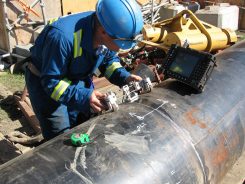Comprehensive Review of Pipeline Welding Evaluation Treatments
In the realm of pipeline construction, guaranteeing the integrity and security of bonded joints is extremely important. Pipe welding inspection treatments play an essential duty in assuring that bonded connections meet strict market requirements and specifications. From precise pre-welding assessments to detailed post-weld analyses, a well-defined evaluation procedure is necessary for preserving the structural stability of pipelines. Comprehending the complexities of welding inspection treatments is not just a regulatory need yet likewise a fundamental element of supporting the integrity of these crucial facilities.
Pre-welding Assessment Preparations
Before starting the welding process, extensive pre-welding examination preparations are vital to guarantee the integrity and high quality of the weld joint. These preparations entail a thorough assessment of the products to be bonded, the welding equipment, and the job setting. By carrying out complete pre-welding examination preparations, prospective problems can be recognized and fixed early on, leading to dependable and high-quality weld joints.
Welding Procedure Certification
Thorough pre-welding assessment prep work lay the foundation for the important procedure of Welding Procedure Credentials, ensuring the honesty and high quality of the weld joint. Welding Procedure Credentials (WPQ) is an important action in the welding process that entails screening and certifying welding treatments to guarantee they satisfy specific criteria and demands. The WPQ procedure generally consists of welding procedure spec development, welding procedure certification screening, and documentation of the outcomes.
During welding procedure requirements development, crucial details such as the welding process, welding materials, joint layout, and welding parameters are specified to create a comprehensive procedure. Consequently, welding treatment qualification testing is carried out to confirm the proposed procedure's integrity. This screening typically entails welding test discount coupons that undergo different mechanical and non-destructive examinations to assess the weld's quality and adherence to the specified standards.
In-process Weld Assessment
Throughout the welding procedure, in-process weld inspection plays an important function in making certain the quality and stability of the weld joint - Pipeline Welding Inspection. This kind of assessment entails keeping an eye on the welding parameters, assessing the weld grain formation, and detecting any kind of possible defects or gaps as they happen. By performing in-process weld assessments, welding drivers can without delay resolve any kind of issues that may emerge, thereby avoiding more flaws and making sure that the final weld meets the required specifications
Usual techniques made use of for in-process weld inspection consist of aesthetic examination, fluid penetrant testing, magnetic fragment testing, ultrasonic testing, and radiographic screening. On the whole, in-process weld assessment is crucial for keeping the top quality and reliability of welded pipes.
Non-destructive Screening (NDT)
Non-destructive Screening (NDT) is an essential technique employed in pipe welding examination to examine the honesty of weld joints without triggering damage to the bonded structure. By using various NDT methods, examiners can examine the high quality of welds and recognize any issues or suspensions that might compromise the architectural soundness of the pipeline. Common NDT techniques made use of in pipe welding examination include Radiographic Screening (RT), Ultrasonic Screening (UT), Magnetic Bit Evaluating (MPT), Fluid Penetrant Testing (LPT), and Visual Screening (VT)
RT includes making use of additional info X-rays or gamma rays to create photos of the internal structure of the weld, permitting assessors to detect problems such as porosity, fractures, or insufficient blend. UT makes use of high-frequency acoustic waves to detect flaws beneath the surface of the weld, using in-depth info regarding the size and location of problems. MPT and LPT are utilized to identify surface-breaking defects by applying penetrant fluids or magnetic fragments to the weld location. Furthermore, VT includes visual inspection of welds to recognize any type of visible blemishes.
Post-weld Assessment and Paperwork


Documentation of post-weld inspection searchings for is vital for keeping high quality control records and ensuring conformity with industry criteria and laws. Comprehensive records must consist of information about the inspection methods utilized, the location and nature of any kind of issues discovered, and any corrective activities taken - Pipeline Welding Inspection. Proper paperwork not just Full Report acts as a record of the weld's high quality yet additionally help in future upkeep and inspection procedures
Conclusion

In conclusion, pipeline welding evaluation procedures play a critical duty in making sure the high quality and integrity of welds. On the whole, adherence to appropriate assessment procedures is crucial to the success of pipeline welding projects.
From thorough pre-welding examinations to comprehensive post-weld analyses, a distinct assessment process is vital for preserving the architectural sturdiness of pipes. By carrying out in-process weld assessments, welding drivers can promptly attend to any type of concerns that might occur, consequently preventing further problems and making sure that the final go to this site weld fulfills the required specifications.
Common methods made use of for in-process weld examination consist of aesthetic evaluation, liquid penetrant screening, magnetic fragment testing, ultrasonic screening, and radiographic screening.Non-destructive Testing (NDT) is an essential approach employed in pipeline welding assessment to assess the honesty of weld joints without creating damage to the welded structure. Post-weld assessment includes different techniques to evaluate the welds for flaws, consisting of visual assessment, color penetrant screening, magnetic bit testing, ultrasonic screening, and radiographic screening.